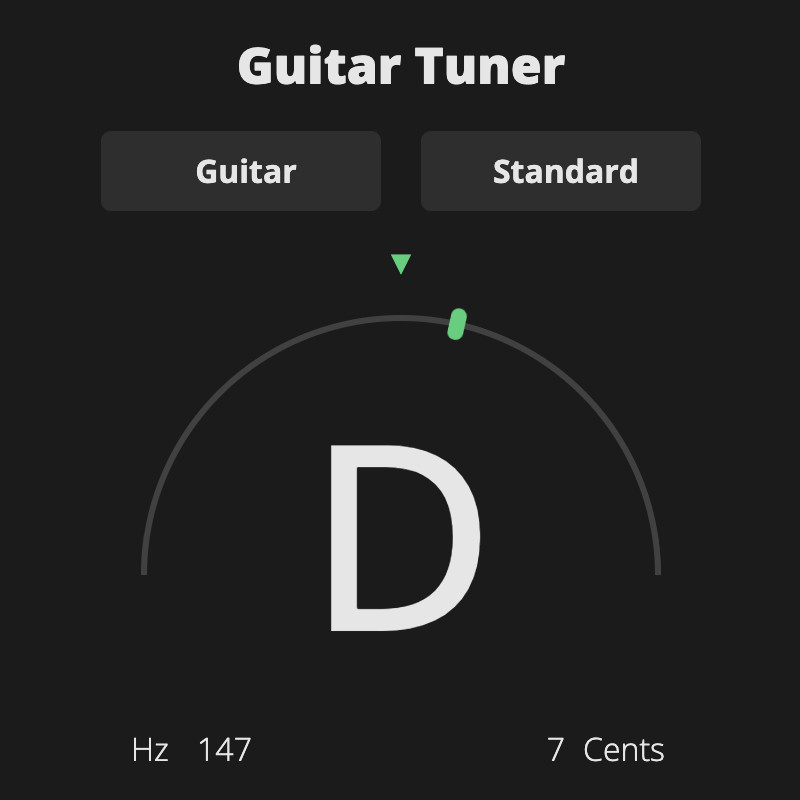Keeping your guitar in tune is crucial, whether you’re practicing, writing, or performing. Standard tuning is the most common, but exploring alternative tunings opens up new sonic landscapes. Eb Standard tuning, also known as half-step down tuning, is a popular alternative that offers a darker, heavier tone favored in genres like blues, rock, and metal. Using an online guitar tuner is a convenient and accurate way to achieve Eb Standard tuning and experiment with this versatile sound.
 Online Guitar Tuner for Eb Standard Tuning – Tune your guitar to Eb with our free web tuner.
Online Guitar Tuner for Eb Standard Tuning – Tune your guitar to Eb with our free web tuner.
How to Tune Your Guitar to Eb Standard with an Online Tuner
Tuning to Eb Standard means lowering the pitch of each string by a half step compared to standard tuning. This results in the strings being tuned to Eb, Ab, Db, Gb, Bb, and Eb, from the thickest to thinnest string. An online guitar tuner simplifies this process, providing visual feedback to ensure accuracy. Here’s how to use one to tune to Eb Standard:
-
Prepare for Tuning: Ensure your guitar is ready to be tuned. If you’re using a physical tuner, make sure it’s on. For an online tuner, like the one provided by GuitarApp, ensure your microphone is enabled and your browser allows microphone access.
-
Select Eb Standard Tuning (If Applicable): Some online tuners allow you to select specific tunings. If your tuner has this option, choose “Eb Standard” or “Half Step Down.” While not strictly necessary for all tuners, this can provide visual cues specific to Eb Standard. If not available, simply aim for each note being a half step lower than standard.
-
Start with the Low E String (Thickest String): In standard tuning, the thickest string is E. For Eb Standard, this needs to be tuned down to Eb. Pluck the string and let it ring clearly.
-
Observe the Tuner: Watch the online tuner interface. It will detect the pitch of the string you just played. The tuner will indicate whether the note is sharp (too high), flat (too low), or in tune. Typically, a needle or indicator will move towards the center when the correct pitch is approached.
-
Adjust the Tuning Peg (Machine Head):
- If the tuner indicates the note is sharp (higher than Eb), you need to loosen the string. Turn the tuning peg connected to the low E string clockwise. Pluck the string again and observe the tuner.
- If the tuner indicates the note is flat (lower than Eb), you need to tighten the string. Turn the tuning peg counter-clockwise. Pluck and check the tuner again.
- Aim for the Center: Continue adjusting the tuning peg until the tuner indicates that the string is precisely in tune at Eb. This is usually represented by the indicator being centered or a visual cue like a green light.
-
Tune Each String in Order: Repeat steps 3-5 for each string, moving from the thickest to thinnest. The target notes for Eb Standard tuning are:
- 6th String (Thickest): Eb
- 5th String: Ab
- 4th String: Db
- 3rd String: Gb
- 2nd String: Bb
- 1st String (Thinnest): Eb
-
Fine-Tuning and Re-Checking: After tuning all six strings, it’s often necessary to go back and re-tune each string again. Adjusting one string can sometimes slightly affect the tuning of others. This iterative process ensures optimal tuning accuracy, especially with new strings or a guitar that was significantly out of tune. Each subsequent pass should be quicker as you get closer to perfect pitch.
Why Tune to Eb Standard?
Eb Standard tuning isn’t just about playing differently; it changes the feel and sound of your guitar. Here’s why guitarists use it:
- Heavier, Darker Tone: Lowering the pitch of all strings creates a naturally darker and heavier tone. This is why Eb Standard is favored in rock, metal, and blues genres, lending itself to powerful riffs and soulful bends.
- Vocal Range Compatibility: Many singers find that Eb Standard tuning better suits their vocal range. Lowering the key by a half step can make songs more comfortable to sing without altering the song’s structure.
- String Tension Reduction: Tuning down reduces the overall tension on the guitar strings. Some guitarists find this makes bending strings easier and reduces finger fatigue, particularly during long playing sessions.
- Genre Authenticity: Eb Standard is deeply rooted in the sound of iconic artists and genres. Tuning to Eb Standard can help you authentically replicate the tones of your favorite songs and artists in blues, rock, and metal.
Exploring Other Guitar Tunings
While Eb Standard offers unique advantages, the world of guitar tuning is vast. Experimenting with different tunings can spark creativity and open up new musical avenues. Here are a few popular alternative tunings:
- Drop D Tuning (D-A-D-G-B-E): Lowering only the lowest string to D creates a powerful bass response, popular in rock and metal for heavier riffs and power chords.
- DADGAD Tuning (D-A-D-G-A-D): Known for its open, resonant sound, DADGAD is favored in Celtic and folk music, creating spacious and atmospheric textures.
- Open G Tuning (D-G-D-G-B-D): Strings are tuned to form a G major chord, ideal for blues and slide guitar, allowing for easy chord voicings and resonant open chords.
- Open D Tuning (D-A-D-F#-A-D): Similar to Open G but tuned to a D major chord. Also popular for blues, slide guitar, and creating rich, sustained sounds.
Types of Guitar Tuners
Online guitar tuners are incredibly accessible, but various types of tuners cater to different needs and preferences:
- Clip-on Tuners: Attach directly to the guitar’s headstock and detect vibrations. Convenient, accurate, and work well even in noisy environments.
- Pedal Tuners: Designed for electric guitarists to integrate into pedalboards. Offer silent tuning on stage and often have bright displays for visibility.
- Mobile App Tuners: Utilize your smartphone’s microphone, similar to online tuners. Portable and readily available.
- Rackmount Tuners: Professional-grade tuners for studios and stage setups, offering advanced features and accuracy.
Choosing the right tuner depends on your playing style, instrument, and environment. Online tuners are a fantastic starting point and a readily available tool for any guitarist.
Tips for Perfect Guitar Tuning
Achieving and maintaining perfect tuning involves more than just using a tuner. Here are some essential tips:
- Use a Quality Tuner: While online tuners are great, investing in a good quality clip-on or pedal tuner can improve accuracy and speed, especially for regular use.
- Stretch New Strings: New strings stretch significantly, causing them to go out of tune quickly. Before tuning, gently stretch new strings by pulling them away from the fretboard. This helps them settle and stay in tune longer.
- Tune Up to Pitch: Always tune up to the correct pitch rather than tuning down. Tuning down can result in slack strings that sound dull and intonation problems. If you overshoot the note, tune down below and then tune back up to the correct pitch.
- Check Tuning Regularly: Temperature and humidity changes, as well as playing, can impact tuning. Make it a habit to check your tuning frequently, especially before and during playing sessions.
- Consider Intonation: Intonation refers to the accuracy of pitch across the fretboard. If your guitar is in tune at the open strings but sounds off as you play up the neck, you may need to adjust your guitar’s intonation – a more advanced setup procedure.
By utilizing an online guitar tuner and following these tips, you can confidently tune your guitar to Eb Standard or any other tuning, ensuring your instrument sounds its best every time you play.

